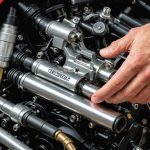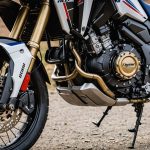Importance of a Steering Damper for Honda VTR1000F
For Honda VTR1000F riders, understanding the function of a steering damper is crucial for enhancing both motorcycle stability and safety features. A steering damper acts much like a shock absorber for the handlebars, mitigating rapid movements that could lead to instability. This becomes particularly important during demanding riding conditions, such as high-speed racing or rough terrain journeys. With a reliable steering damper, the risk of a dangerous wobble or ‘tank slapper’ is significantly reduced, fostering a safer ride.
Without an efficient steering damper, riders may encounter unwelcome surprises. The lack of stabilization can lead to instability, especially during abrupt maneuvers or when encountering uneven road surfaces. Regular maintenance and understanding the integral role of a steering damper can substantially enhance performance, ensuring the motorcycle maintains its handling precision.
Also to discover : Proven strategies to maximize the lifespan of your bmw r1200gs battery
Incorporating a well-functioning steering damper also bolsters rider confidence. By improving motorcycle stability, riders can maximize performance, enjoy smoother rides, and navigate challenging environments with enhanced control, contributing to an overall safer experience. In essence, the steering damper is a key component that directly impacts safety and performance, making it an indispensable part of the Honda VTR1000F.
Tools and Materials Required for Replacement
Replacing the steering damper on a Honda VTR1000F requires precision and the right equipment. Ensuring you have the necessary motorcycle maintenance tools is crucial for a smooth procedure. Below is a list of essential tools:
Topic to read : Ultimate diy guide: enhancing performance by replacing throttle cables on your kawasaki z800
- Socket set: Vital for removing and tightening bolts of various sizes.
- Allen wrenches: Required for screws specifically designed for motorcycles.
- Torque wrench: Ensures bolts are tightened to the manufacturer’s specifications, preventing over-tightening.
Recommended materials include replacement Honda VTR1000F parts such as genuine OEM steering damper components. It’s important to source quality parts to ensure longevity and reliability. Pay attention to product reviews and consult dealership experts to verify part authenticity.
For a successful installation, consider the following tips on sourcing quality replacement parts:
- Dealerships: They often stock certified parts that meet Honda’s standards.
- Online forums: Connect with fellow Honda VTR1000F riders to get recommendations on trusted suppliers.
- Brand reputation: Choose brands with proven reliability in manufacturing motorcycle parts.
Finally, before diving into the replacement process, double-check that all tools and materials are within arm’s reach to avoid interruptions and ensure a more efficient installation.
Step-by-Step Guide to Replacing the Steering Damper
Replacing the steering damper on your Honda VTR1000F can be seamless with a systematic approach. This steering damper installation guide ensures you follow the right motorcycle repair steps.
Preparing the Motorcycle for Replacement
Start by securing the Honda VTR1000F on a stable surface. Disconnect the battery to prevent any electrical mishaps during the process. Ensure all tools for steering damper replacement, including a socket set and torque wrench, are on hand.
Detaching the Old Steering Damper
Begin by loosening the bolts with an appropriate socket from the handlebar area. Carefully detach the damper, noting the alignment and connection points to avoid potential installation pitfalls.
Installing the New Steering Damper
Position the new VTR1000F damper replacement unit, aligning it with the pre-existing holes. Use the torque wrench to tighten bolts to specified levels, ensuring they’re secure but not over-tightened. Double-check alignments and connections for consistency.
These motorcycle repair steps are critical for optimal steering performance. Always refer to the manufacturer’s guidelines to maintain integrity and performance. Taking the time to thoroughly follow each of these steps not only ensures precise installation but also prolongs the effectiveness of the damper.
Common Mistakes to Avoid During Replacement
Replacing the steering damper on a Honda VTR1000F can greatly enhance motorcycle stability and safety features, but attention to detail is crucial to avoid unnecessary complications. One common error involves incorrect torque application. Using a torque wrench ensures bolts are tightened to precise specifications, preventing over-tightening which can lead to damage.
Another mistake is neglecting to align the new damper correctly. Misalignment can result in handling issues, compromising both performance and safety. It’s vital to mark or remember the original position of the old damper to guide the installation of the new one.
Failing to double-check all connections before finishing the installation can lead to loose fittings, which might cause vibrations or instability while riding. Therefore, inspect each bolt and connection point before completing the task.
Additionally, not following the manufacturer’s guidelines can result in installation pitfalls. These guidelines are designed to maintain the integrity of your motorcycle and its components.
By avoiding these common replacement errors, you ensure not just a smoother replacement process, but also a more stable and safer riding experience on your Honda VTR1000F.
Troubleshooting Post-Replacement Issues
After replacing the steering damper on your Honda VTR1000F, meticulous observation is key to ensuring everything functions as intended. One common sign of improper installation is handling vibrations. If your handlebars feel unsteady, inspect the damper’s alignment and ensure all connectors are tightly secured.
Another issue to watch for is misalignment. This can manifest as uneven steering or difficulty maintaining a straight trajectory. Double-check the position of the steering damper and verify that it’s properly adjusted to align with the motorcycle’s geometry.
If problems persist, evaluate the torque settings on all bolts. Using a torque wrench can help rectify errors by tightening components to the manufacturer’s specifications. Such precision can mitigate vibrations and enhance stability.
For persistent issues, it might be wise to seek professional assistance. DIY fixes are practical, but trained mechanics can offer insights you might overlook. They can identify nuanced issues impacting motorcycle stability and recommend effective solutions.
In addressing these post-replacement problems promptly, you safeguard the motorcycle’s performance and your riding safety, ensuring a smoother, more reliable ride. Always prioritise comprehensive checks and professional guidance when in doubt.
Additional Tips for Optimal Performance
Following your steering damper installation on the Honda VTR1000F, implementing motorcycle maintenance best practices is crucial for long-term effectiveness. Routine checks and adjustments can significantly boost steering damper performance.
Begin by regularly inspecting the steering damper for wear and tear. Keep an eye on the mounting points; ensuring they remain tight is vital to avoid unexpected shifts during rides. Adopting a proactive approach to maintenance keeps potential issues at bay.
Enhancing overall handling performance can be achieved by fine-tuning the suspension settings. Adjusting the preload and damping settings in tandem with your riding style can provide a more synchronised ride. Regularly consulting the manufacturer’s guidelines for recommended settings helps maintain a balance between comfort and stability.
Insights from seasoned riders emphasise the importance of proper tyre pressure. Maintaining the correct levels enhances grip, which complements the stabilising effects of the steering damper. Regularly checking tyre conditions can avert unwanted handling vibration issues.
Fuel efficiency and overall stability benefit from these small but impactful adjustments. Continual learning and adaptation, guided by experienced riders’ insights, enhance the Honda VTR1000F performance and lead to safer, smoother rides.











